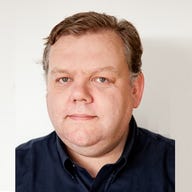Air Semiconductor gets snappy with GPS

Exciting GPS news from Air Semiconductor, a start-up hailing from Swindon. A group of old industry lags with a serious track record in GPS and radio chippery, Air has cooked up Airwave-1, a design that takes between 20 to 100 times less power than other GPS chipsets. The chip survives on a mere milliamp – something an average mobile phone battery could supply continually for forty days.
So frugal is it with the joules, Air claims, that it can be left on all the time in a camera or mobile phone, eliminating that quantum indeterminacy so common in modern electronics:you can know where you are, or you can have the battery left to do something when you get there – just not both at once.
Intrigued by this, I got hold of Stephen Graham, co-founder and VP Marketing (don't panic, he knows what he's talking about). The bad news is, Air isn't saying exactly how it works. The good news is, Graham was happy to talk about enough of the innards to be interesting.
"Our signal processing architecture is different to everyone else's," he told me. "It trades accuracy against power consumption, actively and intelligently. There are six or seven different levers that the architecture pulls, each of which makes that trade-off – for example, duty cycle rate. Turning the receiver on and off to save power – which is very difficult with GPS receivers -- is part of our secret sauce. Everything's highly adapted."
We talked a bit about how GPS worked – multiple satellites broadcasting extremely accurate clock signals combined with ephemera, details of where they are in the sky. A receiver picks up lots of these at once and thus knows how far away it is from each satellite and with what geometry, and thus where it is on the Earth. Normally, that means constantly listening to and decoding many very weak signals, a power-hungry process. Airwave-1 knows how to store and maintain a lot of this information and keep it up to date even with limited reception.
Sensibly, Air has identified one particular niche and applied itself there to get things underway. Its first market is cameras and geotagging photographs – it's shipping sample chips to its customers ("Note the plural") now, with full-on production towards the end of the year and goods on the shelves in the spring of 2010. And was there going to be an "Air Inside" campaign, so the punters know what they're getting? That got a knowing laugh and a "Commercial discussions are still underway".
"As an application," Graham said, "cameras are a special case. We make our solution simpler than anything the competition can provide. When you're not taking a photo, it knows where it is within a few hundred metres. Within 25 milliseconds it can increase resolution to meters – in the time it takes to press the shutter."
I asked him how the device worked if it was in a pocket or bag – where most cameras spend most of their time, after all. "Our sensitivity is -160dBm, comparable to the competition. We're always making the best effort for the power budget, so when we have poor visibility we degrade gracefully. We make best use of what we have – if we can get just one satellite, we still get the timing and ephemeris. When there's no visibility, we report the last position measured. So when you're geotagging and in a building, at least you'll know what building you were in."
The company has other markets in its sights, too. As well as the sales office in Japan, it has one in North Carolina – and there's only one reason for a technology company to pitch its tent next door to Spook Central. As Air Semiconductor knows, this game is all about two things - the location of power, and the power of location.